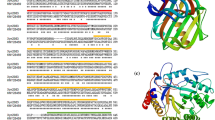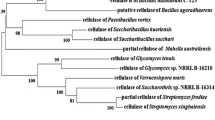Abstract
The camel rumen metagenome is an untapped source of glycoside hydrolases. In this study, novel genes encoding for a modular xylanase (XylC) and a cellulase (CelC) were isolated from a camel rumen metagenome and expressed in Escherichia coli BL21 (DE3). XylC with xylanase (Xyn), CBM, and carbohydrate esterase (CE) domains was characterized as a β-1,4-endoxylanase with remarkable catalytic activity on oat-spelt xylan (K cat = 2919 ± 57 s−1). The implication of XylC’s modular structure in its high catalytic activity was analyzed by truncation and fusion construction with CelC. The resulting fusions including Cel-CBM, Cel-CBM-CE, and Xyn-CBM-Cel showed remarkable enhancement in CMCase activity with K cat values of 742 ± 12, 1289 ± 34.5, and 2799 ± 51 s−1 compared to CelC with a K cat of 422 ± 3.5 s−1. It was also shown that the bifunctional Xyn-CBM-Cel with synergistic xylanase/cellulase activities was more efficient than XylC and CelC in hydrolysis of rice and barley straws.






Similar content being viewed by others
References
Anwar Z, Gulfraz M, Irshad M (2014) Agro-industrial lignocellulosic biomass a key to unlock the future bio-energy: a brief review. J Radiat Res Appl Sci 7(2):163–173
Bradford MM (1976) A rapid and sensitive method for the quantitation of microgram quantities of protein utilizing the principle of protein-dye binding. Anal Biochem 72(1–2):248–254
Chang L, Ding M, Bao L, Chen Y, Zhou J, Lu H (2011) Characterization of a bifunctional xylanase/endoglucanase from yak rumen microorganisms. Appl Microbiol Biotechnol 90(6):1933–1942
Collins T, Meuwis M-A, Stals I, Claeyssens M, Feller G, Gerday C (2002) A novel family 8 xylanase, functional and physicochemical characterization. J Biol Chem 277(38):35133–35139
Collins T, Gerday C, Feller G (2005) Xylanases, xylanase families and extremophilic xylanases. FEMS Microbiol Rev 29(1):3–23
Gangwar AK, Prakash NT, Prakash R (2014) Applicability of microbial xylanases in paper pulp bleaching: a review. Bioresources 9(2):3733–3754
Gharechahi J, Zahiri HS, Noghabi KA, Salekdeh GH (2015) In-depth diversity analysis of the bacterial community resident in the camel rumen. Syst Appl Microbiol 38(1):67–76
Ghatge SS, Telke AA, Kang S-H, Arulalapperumal V, Lee K-W, Govindwar SP, Um Y, Oh D-B, Shin H-D, Kim S-W (2014) Characterization of modular bifunctional processive endoglucanase Cel5 from Hahella chejuensis KCTC 2396. Appl Microbiol Biotechnol 98(10):4421–4435
Gírio FM, Fonseca C, Carvalheiro F, Duarte LC, Marques S, Bogel-Łukasik R (2010) Hemicelluloses for fuel ethanol: a review. Bioresour Technol 101(13):4775–4800
Golan AE (2010) Cellulase: types and action, mechanism, and uses. Nova Science Publishers, New York
Goncalves GA, Takasugi Y, Jia L, Mori Y, Noda S, Tanaka T, Ichinose H, Kamiya N (2015) Synergistic effect and application of xylanases as accessory enzymes to enhance the hydrolysis of pretreated bagasse. Enzym Microb Technol 72:16–24
Henshaw JL, Bolam DN, Pires VM, Czjzek M, Henrissat B, Ferreira LM, Fontes CM, Gilbert HJ (2004) The family 6 carbohydrate binding module CmCBM6-2 contains two ligand-binding sites with distinct specificities. J Biol Chem 279(20):21552–21559
Hong SY, Lee JS, Cho KM, Math RK, Kim YH, Hong SJ, Cho YU, Kim H, Yun HD (2006) Assembling a novel bifunctional cellulase–xylanase from Thermotoga maritima by end-to-end fusion. Biotechnol Lett 28(22):1857–1862
Hong S-Y, Lee J-S, Cho K-M, Math RK, Kim Y-H, Hong S-J, Cho Y-U, Cho S-J, Kim H, Yun H-D (2007) Construction of the bifunctional enzyme cellulase-β-glucosidase from the hyperthermophilic bacterium Thermotoga maritima. Biotechnol Lett 29(6):931–936
Jemli S, Ayadi-Zouari D, Hlima HB, Bejar S (2016) Biocatalysts: application and engineering for industrial purposes. Crit Rev Biotechnol 36(2):246–258
JoBoyce A, Walsh G (2015) Characterisation of a novel thermostable endoglucanase from Alicyclobacillus vulcanalis of potential application in bioethanol production. Appl Microbiol Biotechnol 99(18):7515–7525
Juturu V, Wu JC (2014) Microbial cellulases: engineering, production and applications. Renew Sust Energ Rev 33:188–203
Knowles J, Lehtovaara P, Teeri T (1987) Cellulase families and their genes. Trends Biotechnol 5(9):255–261
Kosugi A, Murashima K, Doi RH (2002) Xylanase and acetyl xylan esterase activities of XynA, a key subunit of the Clostridium cellulovorans cellulosome for xylan degradation. Appl Environ Microbiol 68(12):6399–6402
Kumar S, Stecher G, Tamura K (2016) MEGA7: molecular evolutionary genetics analysis version 7.0 for bigger datasets. Mol Biol Evol 33(7):1870–1874
Laemmli UK (1970) Cleavage of structural proteins during the assembly of the head of bacteriophage T4. Nature 227(5259):680–685
Limayem A, Ricke SC (2012) Lignocellulosic biomass for bioethanol production: current perspectives, potential issues and future prospects. Prog Energy Combust Sci 38(4):449–467
Liu X, Huang Z, Zhang X, Shao Z, Liu Z (2014) Cloning, expression and characterization of a novel cold-active and halophilic xylanase from Zunongwangia profunda. Extremophiles 18(2):441–450
Liu Y, Huang L, Li W, Guo W, Zheng H, Wang J, Lu F (2015) Studies on properties of the xylan-binding domain and linker sequence of xylanase XynG1-1 from Paenibacillus campinasensis G1-1. J Ind Microbiol Biotechnol 42(12):1591–1599
Madern D, Ebel C, Zaccai G (2000) Halophilic adaptation of enzymes. Extremophiles 4(2):91–98
Mert MJ, la Grange DC, Rose SH, van Zyl WH (2016) Engineering of Saccharomyces cerevisiae to utilize xylan as a sole carbohydrate source by co-expression of an endoxylanase, xylosidase and a bacterial xylose isomerase. J Ind Microbiol Biotechnol 43(4):431–440
Miller GL (1959) Use of dinitrosalicylic acid reagent for determination of reducing sugar. Anal Chem 31(3):426–428
Pai C-K, Wu Z-Y, Chen M-J, Zeng Y-F, Chen J-W, Duan C-H, Li M-L, Liu J-R (2010) Molecular cloning and characterization of a bifunctional xylanolytic enzyme from Neocallimastix patriciarum. Appl Microbiol Biotechnol 85(5):1451–1462
Rashamuse K, Visser D, Hennessy F, Kemp J, Roux-van der Merwe M, Badenhorst J, Ronneburg T, Francis-Pope R, Brady D (2013) Characterisation of two bifunctional cellulase–xylanase enzymes isolated from a bovine rumen metagenome library. Curr Microbiol 66(2):145–151
Rizk M, Elleuche S, Antranikian G (2015) Generating bifunctional fusion enzymes composed of heat-active endoglucanase (Cel5A) and endoxylanase (XylT). Biotechnol Lett 37(1):139–145
Siddiqui KS, Cavicchioli R (2006) Cold-adapted enzymes. Annu Rev Biochem 75:403–433
Sun J, Wang H, Lv W, Ma C, Lou Z, Dai Y (2011) Construction and characterization of a fusion β-1, 3-1, 4-glucanase to improve hydrolytic activity and thermostability. Biotechnol Lett 33(11):2193
Thomas L, Parameswaran B, Pandey A (2016) Hydrolysis of pretreated rice straw by an enzyme cocktail comprising acidic xylanase from Aspergillus sp. for bioethanol production. Renew Energy 98:9–15
Van Den Burg B (2003) Extremophiles as a source for novel enzymes. Curr Opin Microbiol 6(3):213–218
Van Dyk J, Pletschke B (2012) A review of lignocellulose bioconversion using enzymatic hydrolysis and synergistic cooperation between enzymes—factors affecting enzymes, conversion and synergy. Biotechnol Adv 30(6):1458–1480
Van Soest P (2006) Rice straw, the role of silica and treatments to improve quality. Anim Feed Sci Technol 130(3):137–171
Wejse PL, Ingvorsen K, Mortensen KK (2003) Purification and characterisation of two extremely halotolerant xylanases from a novel halophilic bacterium. Extremophiles 7(5):423–431
Yang H, Liu L, Xu F (2016) The promises and challenges of fusion constructs in protein biochemistry and enzymology. Appl Microbiol Biotechnol 100(19):8273–8281
Acknowledgements
This work was supported by National Institute of Genetic Engineering and Biotechnology (NIGEB) (Grant Nos. 518 and 578).
Author information
Authors and Affiliations
Corresponding author
Ethics declarations
Conflict of interest
The authors declare that they have no conflict of interest.
Ethical approval
This article does not contain any studies with human participants or animals performed by any of the authors.
Rights and permissions
About this article
Cite this article
Khalili Ghadikolaei, K., Akbari Noghabi, K. & Shahbani Zahiri, H. Development of a bifunctional xylanase-cellulase chimera with enhanced activity on rice and barley straws using a modular xylanase and an endoglucanase procured from camel rumen metagenome. Appl Microbiol Biotechnol 101, 6929–6939 (2017). https://doi.org/10.1007/s00253-017-8430-2
Received:
Revised:
Accepted:
Published:
Issue Date:
DOI: https://doi.org/10.1007/s00253-017-8430-2




